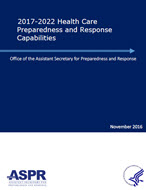
|
|
The 2017-2022 Health Care Preparedness and Response Capabilities document outlines the high-level objectives that the nation’s health care delivery system, including health care coalitions (HCCs) and individual health care organizations, should undertake to prepare for, respond to, and recover from emergencies. These capabilities illustrate the range of preparedness and response activities that, if conducted, represent the ideal state of readiness in the United States. The 2017-2022 Health Care Preparedness and Response Capabilities document improves upon the 2012 version titled Healthcare Preparedness Capabilities: National Guidance for Healthcare System Preparedness, streamlining eight capabilities down to four. HPP awardees and sub-awardees will begin to implement the four capabilities presented in the 2017-2022 Health Care Preparedness and Response Capabilities document starting in the new HPP project period, which begins in July 2017.
|
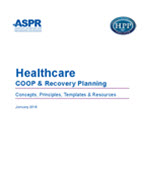
|
|
The Healthcare Continuity of Operations (COOP) & Recovery Planning document describes the concepts, principles, templates and resources available to assist non-federal healthcare entities in identifying and ensuring planning methodologies align with current federal continuity and recovery framework guidelines. This document is a collection of resources, ideas, templates and references and hyperlinks to additional information relating to Healthcare COOP and Healthcare Disaster Recovery. It may be used to develop plans, checklists, concepts of operations and other documents and tools related to Healthcare COOP and Recovery planning. Learn More >>
|
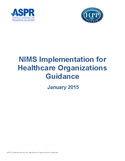
|
|
This guidance provides implementation guidance and examples for the National Incident Management System (NIMS) implementation objectives: adoption; preparedness planning; preparedness training and exercises; communications and information management; and command and management. NIMS provides a systematic, proactive approach guiding departments and agencies at all levels and their partners to work seamlessly to prepare for, prevent, respond to, recover from, and mitigate the effects of incidents, regardless of cause, size, location, or complexity, in order to reduce the loss of life, property, and harm to the environment. Learn More >> |
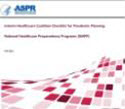 |
|
In conjunction with other tools, the Healthcare Coalition Checklist for Pandemic Planning can help a Healthcare Coalition expand its pandemic influenza emergency response plan to include a diverse mix of partners including schools, businesses, community organizations, and government agencies. Cover Letter | Checklist
|
 |
|
In response to the Middle East Respiratory Syndrome Coronavirus (MERS-CoV), the Office of the Assistant Secretary for Preparedness and Response (ASPR) is collaborating with the Centers for Disease Control and Prevention and its partners to gather more details on this virus and methods to detect and manage it. Cover Letter | Guidance
|
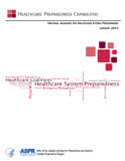 |
|
The Healthcare Preparedness Capabilities: National Guidance for Healthcare System Preparedness will help state, local, Healthcare Coalition, and ESF #8 planners identify gaps in preparedness, determine specific priorities, and develop plans for building and sustaining healthcare specific capabilities. These capabilities are designed to facilitate and guide joint ESF #8 preparedness planning and ultimately assure safer, more resilient, and better-prepared communities. Learn More >> |
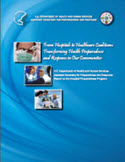 |
|
Since the creation of the HPP in 2002, States and hospitals, along with the public health and emergency management communities, have worked tirelessly to improve the State of medical and public health preparedness. This report provides an up-to-date snapshot of their progress. HPP is also at a point in its evolution where significant enhancements are necessary in order to more broadly include the entire healthcare community and to make preparedness a community attribute instead of a facility one. Learn More >> |
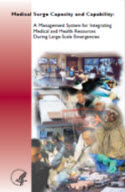 |
|
The Medical Surge Capacity and Capability (MSCC) Handbook describes a systematic approach for managing the medical and public health response to an emergency or disaster. The MSCC handbook identifies recent changes to the Federal emergency response structure, particularly the Federal public health and medical response. It also expands on several concepts described in the first edition of the MSCC handbook to facilitate their implementation. While the tiered approach described in this handbook is consistent with NIMS and the NRP, this revision addresses terminology and concept descriptions to assure consistency with Federal guidance. Learn More >> |
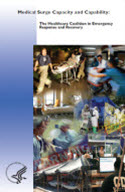 |
|
MSCC: The Healthcare Coalition in Emergency Response and Recovery provides guidance to healthcare planners on how to develop, implement, and maintain cost-effective and response-oriented Healthcare Coalitions. It describes the common elements of an effective Healthcare Coalition that may be applied in any locale to operationally support individual healthcare organizations and the larger community response to emergencies or disasters. The Coalition is highlighted as an emergency response organization in order to distinguish this handbook from other efforts that are underway across the U.S. that primarily coordinate emergency preparedness. Learn More >> |